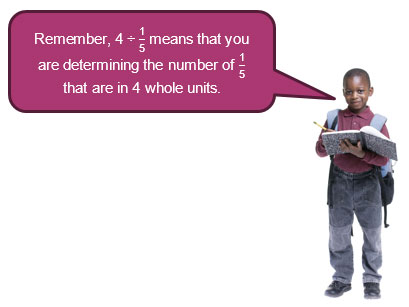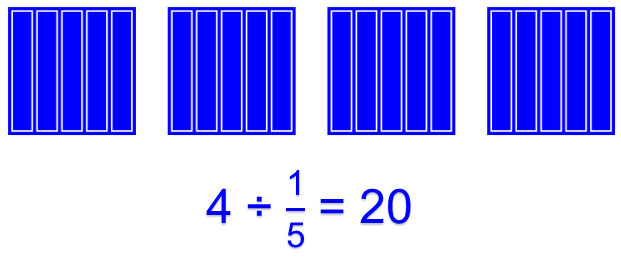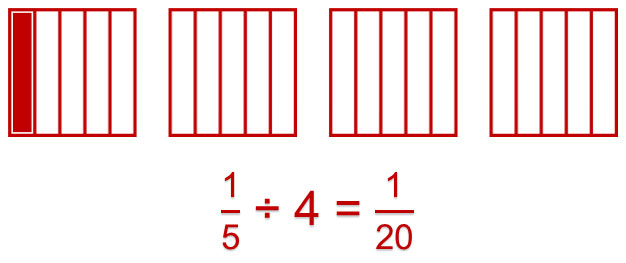
In a previous grade, you worked with division of whole numbers and unit fractions. For example, 4 ÷ 1 over 5 1 5 can be represented using fraction squares.

Breaking 4 whole units into fifths reveals 20 fifths.

Likewise, you can also divide a unit fraction by a whole number. For example, 1 over 5 1 5 ÷ 4 can be represented using a fraction square. This division sentence is asking, “how many 4’s are in 1 over 5 1 5 ?”

From the model, you can see that there is 1 over 20 1 20 of 4 in 1 over 5 1 5 .
In this section, you will explore how to divide fractions by other fractions.
Maria has 2 over 3 2 3 yard of ribbon. Each bow that she is making requires 1 over 6 1 6 of a yard. How many bows can Maria make?
![]() Use the interactive below to see how to visually represent the division sentence 2 over 3
2
3
÷ 1 over 6
1
6
.
Use the interactive below to see how to visually represent the division sentence 2 over 3
2
3
÷ 1 over 6
1
6
.
Brandon has 2 over 3 2 3 pound of chocolate. He has several containers that will each hold 1 over 2 1 2 pound of chocolate. How many containers can Brandon fill?
![]() Use the interactive below to see how to visually represent the division sentence 2 over 3
2
3
÷ 1 over 2
1
2
.
Use the interactive below to see how to visually represent the division sentence 2 over 3
2
3
÷ 1 over 2
1
2
.
Use the two problems above to answer the questions that follow.
Interactive popup. Assistance may be required.
2 over 3 2 3 × 6 = 4
Interactive popup. Assistance may be required.
The quotient of 2 over 3 2 3 ÷ 1 over 6 1 6 is 4, which is the same as the product of 2 over 3 2 3 × 6.
Interactive popup. Assistance may be required.
2 over 3 2 3 × 2 = 4 over 3 4 3
Interactive popup. Assistance may be required.
The quotient of 2 over 3 2 3 ÷ 1 over 2 1 2 is 4 over 3 4 3 , which is the same as the product of 2 over 3 2 3 × 2.
How does the quotient of two fractions compare to the product of the dividend and the reciprocal of the divisor?
Alecia has 5 over 6 5 6 gallon of lemonade. She has containers that each hold 2 over 3 2 3 gallon. How many containers can Alecia fill?
![]() Use the interactive below to see how to visually represent the division sentence 5 over 6
5
6
÷ 2
over 3
2
3
.
Use the interactive below to see how to visually represent the division sentence 5 over 6
5
6
÷ 2
over 3
2
3
.
Use the problem above to answer the questions that follow.
Interactive popup. Assistance may be required.
5 over 6 5 6 × 3 over 2 3 2 = 15 over 12 15 12 = 5 over 4 5 4 = 11 over 4 1 4
Interactive popup. Assistance may be required.
The quotient of 5 over 6 5 6 ÷ 2 over 3 2 3 is 11 over 4 1 4 , which is the same as the product of 5 over 6 5 6 × 3 over 2 3 2 .
If the numerator of the divisor is not 1, does the relationship between the quotient of two fractions and the product of the dividend and the reciprocal of the divisor change? Why or why not?
Interactive popup. Assistance may be required.
What is the reciprocal of the divisor, 5 over 12 5 12 ?
Interactive popup. Assistance may be required.
The area of a rectangle is the product of the length and width of the rectangle. If you know the area, divide by the known dimension to determine the missing dimension.
Interactive popup. Assistance may be required.
To determine the number of 5 over 8 5 8 that there are in 10, divide 10 by 5 over 8 5 8 .